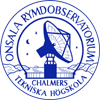Wobbling secondary
In 2007 the static subreflector was successfully replaced with a chopping subreflector.
The new wobbler will, in the cases where it can be used, improve the quality
of the observations. By chopping quickly between two positions on sky (the "throw"), the observations will be less
sensitive to time dependent instabilities in the receivers and the atmosphere. Currently, the wobbler can only be used together with the heterodyne receivers.
The wobbling secondary has the following specifications:
- Azimuthal throw up to 300 arcsec.
- Chopping rates up to 2.0 Hz. For chopping rates above 1.5 Hz the maximum
azimuthal throw in arcsec is given by:
Max. throw = 300 - 100*(R-1.5) arcsec
where R is the chopping rate in Hz.
- The duty cycle (efficiency) is around 90% at R=0.5 Hz.
For R=2.0 Hz it is 70-80% depending on the size of the throw.
When doing spectroscopic measurements with the heteorodyne receivers it is
recommended not to use
R=1.0 Hz as switching rate since it will be
in resonance with the cryogenics pump cycle of 1 Hz. However, in the case of
total power scans with the heterodyne receivers it is an advantage to use
R=1.0 Hz. The wobbling secondary is improving the quality of the
observations when observing sources with extent less than 5 arcmin. Typical
sources where its use would be beneficial are circumstellar envelopes, planets,
molecular hot cores, and most galaxies.






